On-chain research: What did DAOs, which received ARB airdrops, do with the money?
Original authors: unex, Amir Ormu, and Atomist
Translation: Luffy
Several months ago, Arbitrum airdropped over $125 million worth of ARB tokens to the protocol DAOs in its ecosystem. The Arbitrum airdrop has been one of the most anticipated airdrop events this year, and we're curious: what have these receiving protocols actually done with millions of dollars?
Governance Token Distribution
On April 24th, the Arbitrum Foundation began distributing 1.128 billion ARB tokens to eligible protocols within its ecosystem.
A total of 137 protocols received the token airdrop. To avoid concentration of token distribution, the Arbitrum Foundation collaborated with Nansen to devise an airdrop strategy that enhances diversity among projects with different KPIs and use cases.
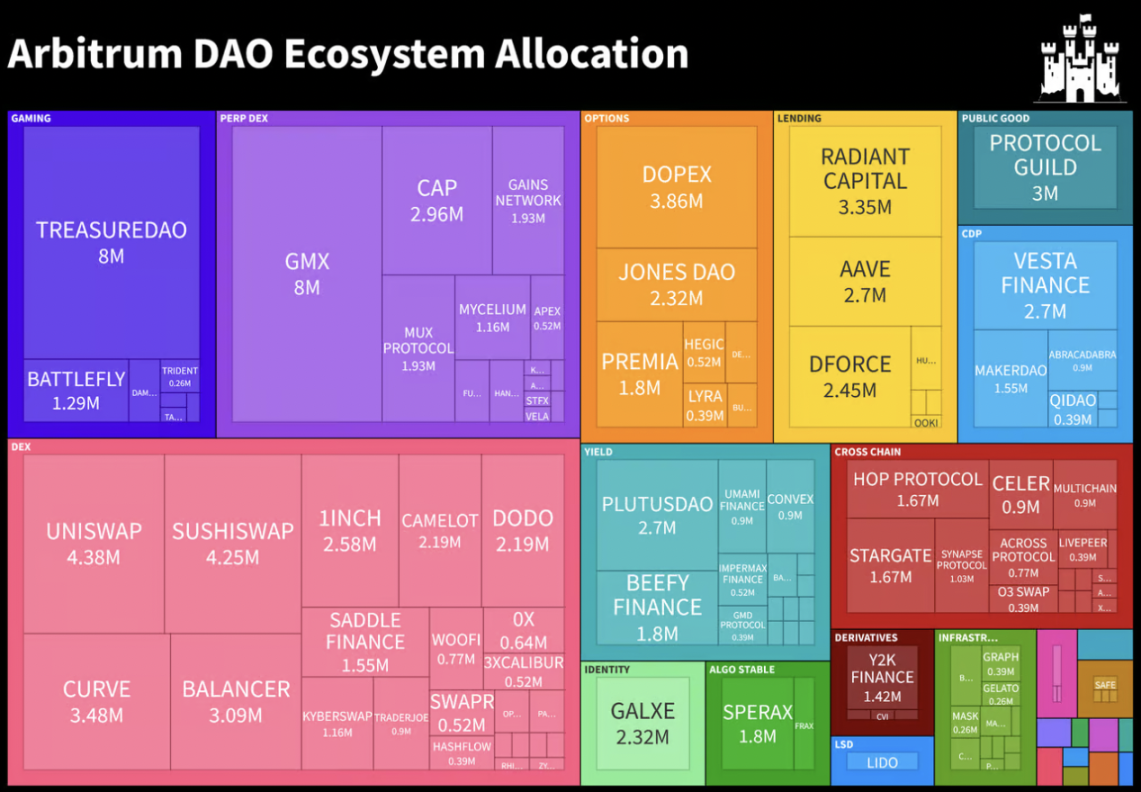
A visual representation of the Arbitrum DAO airdrop divided by scale and category
These protocols have complete autonomy to decide how to utilize the airdropped tokens they received. They can use the funds to directly or retroactively reward users, engage in vote buying, or use them as operational funds.
In a blog post discussing this specific airdrop initiative, the Arbitrum team clarified that the fundamental goal of token distribution is "localization of community governance." The direct allocation of tokens to the treasuries of Arbitrum protocols is aimed at enabling them to take up governance responsibilities and participate in decision-making processes within the ecosystem.
This approach allows protocols to leverage this airdrop to support their operations and drive platform or product development, ensuring a brighter future for the protocol and the underlying Arbitrum ecosystem.
In the months following the launch of ARB tokens, some may overlook L2, thinking there aren't many opportunities left. However, we believe that even in this crypto winter, the L2 ecosystem is filled with catalysts, including:
The content of these catalysts is beyond the scope of this article, and we will not delve into it here.
On-chain investigation results and Dune dashboard
In this report, we will focus on the on-chain research findings around the Arbitrum airdrop project. Our goal is to provide market participants with insights into capital flows and the integrity of fund decision-making for each DAO.
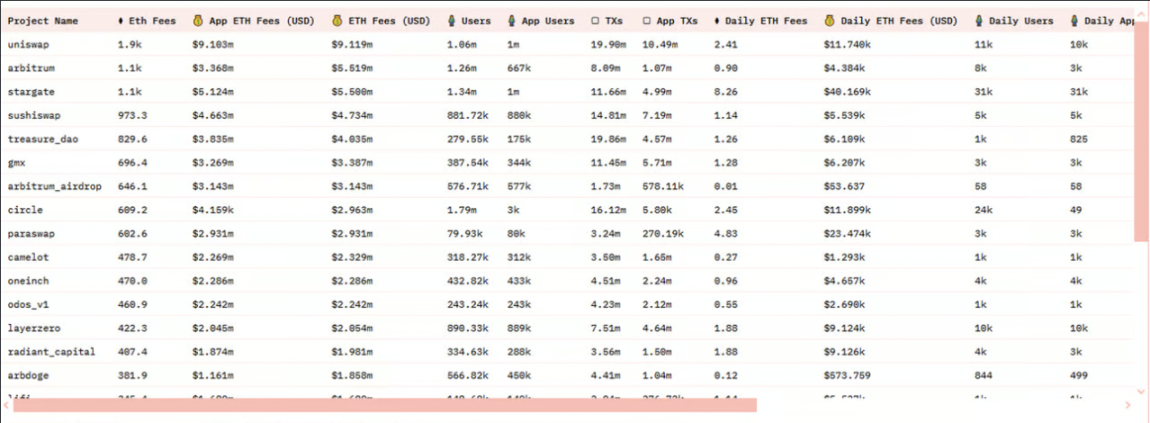
Protocol and Metrics, as of June 23, 2023
In addition, our member Shogun has created a Dune dashboard that provides an overview of the initial ARB allocation and current balance of all protocols, in addition to a series of metrics such as user count, transaction count, and accrued fees.
Disclaimer: Since we cannot always track the movements of all 139 treasury wallets, the findings in this article are only limited to the trends as of June 23rd.
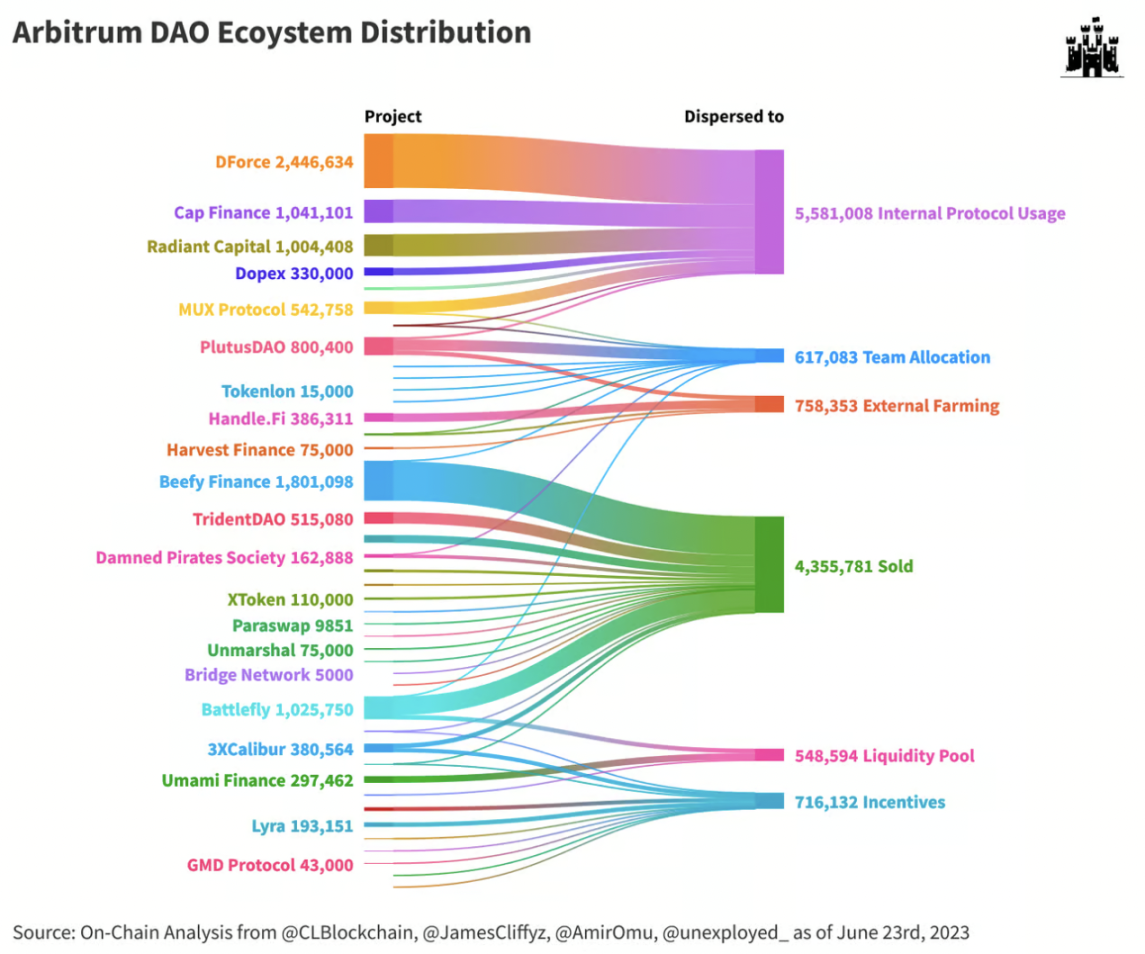
Stranded Whales
Among the protocols that received the largest amount of airdrop tokens, GMX (8 million ARB), Uniswap (4.3 million ARB), SushiSwap (4.2 million ARB), and Curve (3.3 million ARB) have not utilized any of the airdrop tokens or proposed any noteworthy governance proposals for fund allocation. Arrakis is proposing to distribute the airdropped tokens received by Uniswap to liquidity providers on the DEX through Arrakis.

4 out of the top 5 recipients have not transferred or used any ARB tokens
Balancer, Radiant, and Stargate Reward LP
Balancer has initiated and approved a proposal to reward LP. The protocol has received 3 million tokens and plans to reward active liquidity providers with 1 million tokens in batches (10,000 ARB every two weeks). Additionally, the proposal suggests using the remaining 2 million tokens to deploy POL (Protocol Owed Liquidity) by combining the liquidity pool BAL/AURA/ARB with Aura.
Radiant received 3.4 million ARB tokens, becoming another major airdrop recipient. Radiant has approved a governance proposal regarding the airdrop distribution (RFP-18):
40% airdropped to all new 6-month and 1-year dLP locked users.
30% distributed next year to all Arbitrum dLP locked users.
30% reserved in the treasury for future use.
Stargate DAO received 1.7 million ARB, and their latest proposal regarding the token distribution has been approved. 70% of the tokens will be used for liquidity mining incentives on Arbitrum, and the release of STG will be paused until ARB is depleted. This means that all LPs will migrate to the new contract to receive ARB rewards.
Stargate plans to allocate the remaining 30% to partners to encourage greater collaboration in advancing the Arbitrum and Stargate ecosystem.
TreasureDAO funds game developers
TreasureDAO (receiving 8 million ARB) launched an interesting proposal on the governance forum on May 9th, which will be voted on June 1st.
According to the proposal, 2 million ARB tokens will be allocated to reward contributing game developers. Initially, 500,000 tokens will be distributed to builders through donations or treasury swaps. The remaining 1.5 million tokens will be reserved for future rewards or grants. Game studios receiving rewards include: The Beacon, Realm, Tales of Elleria, Knights of the Ether, The Lost Donkeys, Smithonia, Ruffion Reborn, CastleDAO, Power Plins, City Clash, Smol Age, Billy's World, and Kasumi Dungeons. The specific allocation amounts are currently unclear.
Dopex and Cap: Liquidity and Incentives
Dopex received a 3.8 million token airdrop. Founder tztokchad stated on Discord on April 25th that the airdrop will be divided into collateral for dpxETH, incentive measures, and rewards for long-term holders. Now, after nearly 2 months, the protocol has used 300,000 ARB to provide liquidity for options products. Additionally, 30,000 ARB tokens were sent to 0x...7d...0b and then distributed to addresses suspected to be staking contracts.
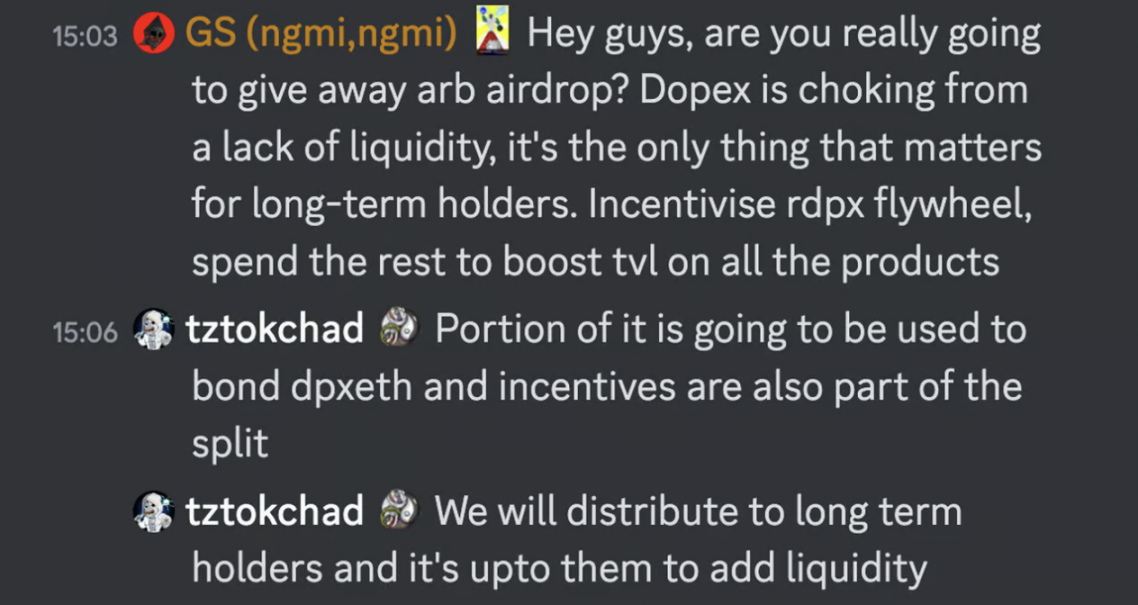
Response from tztokchad on April 25, 2023
Cap Finance used a similar approach with their airdrop. They sold 1 million tokens for the price of 576,000 USDC and 311 ETH to provide liquidity for their trading pool. Additionally, they distribute 100,000 ARB tokens to users every month based on trading volume.
PlutusDAO
Plutus (receives 2.7 million ARB) distributed 500,000 tokens to team members without waiting for any community resolution.

In addition, Plutus plans to use 300,000 ARB to repurchase plsARB and distribute it to plsARB stakers. Interestingly, there is no official liquidity pool available for plsARB holders to convert their plsARB back to ARB.
Currently, the only available liquidity pool has 16,000 ARB liquidity, and the trading price of plsARB is 30% lower than the pegged value. It is worth noting that this is not an official pool and the Plutus team has been waiting for Camelot's centralized liquidity pool to launch a new and more liquid trading pool. So, for the 2,936 holders, they will have to continue waiting (which has been more than 3 months) for the team to come up with a solution.

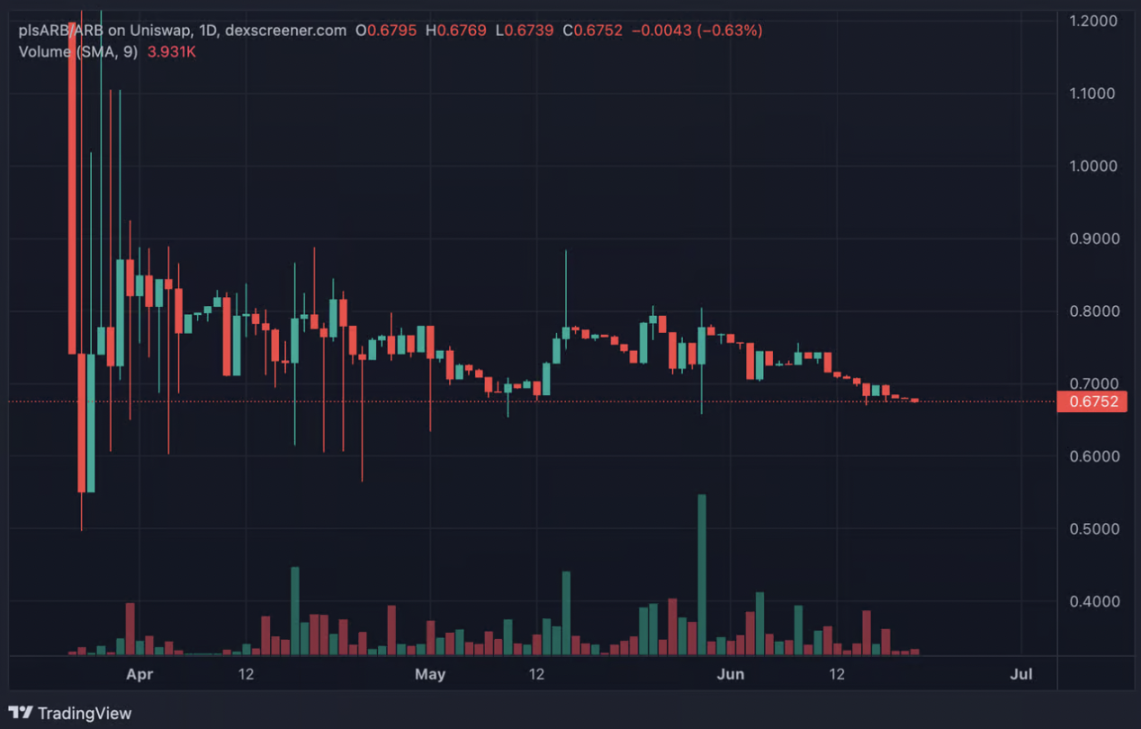
plsARB/ARB liquidity pool as of June 23, 2023
We discovered that to fill the illiquidity black hole of plsARB, the team utilized 100,000 ARB to provide funding for the supplier pool here, allowing plsARB to be borrowed against as collateral. Lastly, they provided 200,000 ARB in the lending pool of Silo Finance for yield generation, the specific reason is unknown to us.
Other projects with allocations of over 600,000 ARB
DForce (received 2.4 million ARB) will airdrop for POL: placing all airdrop into its own lending pool.
Beefy.Finance (received 1.8 million ARB) will use the airdrop for operations and incentives: seemingly distributing 1.3 million tokens as incentives and converting 100,000 ARB into USDC for operations.
BattleFly (received 1.2 million ARB) sold 280,000 ARB.
KyberSwap (received 1.1 million ARB) used 152,000 ARB as incentives.
Umami Finance (received 900,000 ARB) created on-chain selling order monitoring.
Multichain (received 900,000 ARB) used 167,000 ARB as incentives.
0 x Protocol (received 643,000 ARB) kept all airdrops in EOA - it's the only project doing so.
Impermax (received 500,000 ARB) sent 100,000 ARB to EOA and LP on its platform.
3 xcalibur (received 500,000 ARB) airdropped 100,000 ARB to LP and plans an additional 100,000 ARB if TVL remains at 1 million USD. 3 xcalibur also uses some for bribes/rewards and plans to use some for operations in the future.
For smaller projects, we recommend using Dune Dashboard to view, so you can do some data mining yourself. We believe their movements are not worth specifically describing as the majority of projects still hold airdrops.
We do want to mention all the sold airdrop projects: TridentDAO, Damned Pirates Society, Covalent, XToken, Bridge Network, Rice DeFi, ApolloX, CREDA, Aelin, Unmarshal, and ZeroSwap.
Conclusion
In summary, the majority of airdropped tokens remain idle in multi-signature wallets (representing about 80% of all airdropped tokens) and seem to align with the overall vision of empowering protocols to take responsibility for governance and decision-making within the ecosystem.
While some protocols directly sell all airdrops to fund their operations, we believe these funds will be used to stimulate protocol growth and indirectly benefit the entire Arbitrum ecosystem.
A new issue that emerged in our research is that some sellers portray themselves as DAOs operating according to community governance but are unwilling to share their distribution plans with their community.
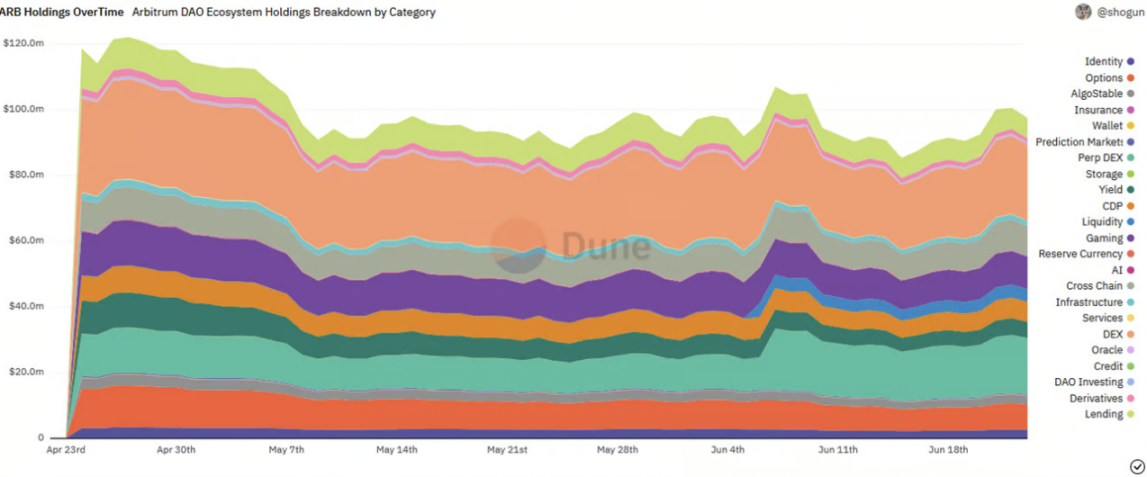
As of June 23, 2023, ARB holdings classified by category
In an ideal scenario, these projects will:
Reserve tokens for future Arbitrum governance;
Reallocate their value to the community to incentivize product growth within the Arbitrum ecosystem.
By simply tracking on-chain token movements and behaviors from multisig wallets, we can differentiate more clearly those who are more inclined to participate in the development of the Arbitrum ecosystem.
We encourage anyone interested to conduct some on-chain investigations on our Dune dashboard. This should be one of the main takeaways of this article: on-chain accountability of the protocol.
In fact, it is often difficult to truly understand what is happening behind the scenes of Web 3 projects. The on-chain accountability of governance airdrops on Arbitrum has the advantage of greater transparency and the ability to monitor how these protocols effectively utilize allocated funds. This is the second interesting practice (Optimism being the first) that we believe is an interesting model and will be replicated by other projects in the future.
To further tailor the incentive measures, future governance airdrop allocations may set restrictions on certain token behaviors, such as limiting sales or enforcing long-term cash-outs. Nevertheless, we believe the current distribution is fair and a natural selection of which protocols are more aligned with and which protocols are not aligned with the Arbitrum ecosystem. If we look back, Optimism's airdrop had some restrictions.
However, on-chain analysis can only provide one aspect of the story. For this reason, we would like to invite all relevant protocols to maintain transparency regarding their airdrop plans.



